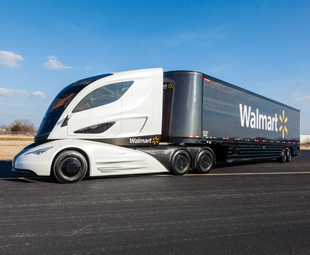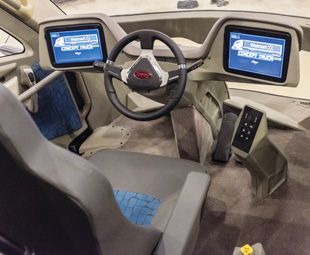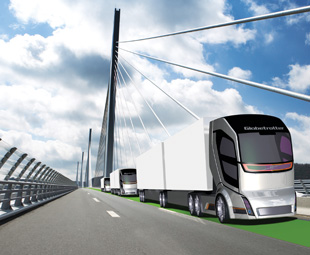Of space-age trucks and a brighter tomorrow

Trucks have come a long way, evolving from mechanical monsters (which you could fix with a Swiss Army knife), to refined workhorses – with more electronic cleverness than a smartphone … But how will trucking change into the future? JACO DE KLERK investigates.
The inventor, entrepreneur and forward thinker Gottlieb Daimler has been accredited with building the world’s first truck in 1896: a type of carriage built on ironclad wooden wheels with a two-cylinder engine, which offered 3 kW of power from a displacement of 1,06 litres, instead of a drawbar …
(You can read more about Daimler’s achievements, and his first commercial vehicle, in The Daimler Legacy on our website’s “The Latest News” section.)
Trucks, however, have come a long way from their “converted horse-drawn cart” heritage … Folks from the 1800s might have called today’s units figments of Herbert George Wells’s imagination.
(Wells, better known as H.G. Wells, was an English writer renowned for his work in the science fiction genre. He’s sometimes called “The Father of Science Fiction”, with his most notable works including: The War of the Worlds, The Time Machine, The Invisible Man and The Island of Doctor Moreau.)
But Wal-Mart Stores, better known as Walmart – a multinational retail corporation, based in the United States, that runs chains of large, discount department and warehouse stores (both physically and through e-commerce) – has also developed a truck that would leave modern-day folks gawking …
The Walmart Advanced Vehicle Experience, or WAVE, is a tractor-trailer combination that resembles a spaceship rather than a commercial vehicle. It features impressive aerodynamics; an advanced turbine-powered, range-extending series hybrid powertrain (which currently runs on diesel, but can run on compressed or liquid natural gas and biofuels, as the turbine is fuel neutral); electrified auxiliary components; and sophisticated control systems – all in one package. The WAVE was developed in support of the company’s sustainability programme.
In 2005, Walmart – one of America’s largest private fleet operators, with its trucks logging millions of kilometres every year – announced its goal to double fleet efficiency by 2015. As of last year, the company reports that it has achieved an 84 percent improvement in fleet efficiency over the original baseline.
“Walmart is continually looking for innovative ways to increase our efficiencies and reduce our fleet’s emissions,” says Tracy Rosser, senior vice president of the company’s transportation. “The WAVE is a bold step in transportation technologies that, although it isn’t on the road in its current form, will serve as a learning platform for the future and will accelerate our progress toward our goals.”
The space-age commercial vehicle is the result of collaboration between Walmart and many vendors including: Peterbilt, Roush Engineering, Great Dane Trailers and Capstone Turbine.
 Walmart states that it has collaborated with Peterbilt on aerodynamic, hybrid, electrification and alternative-fuel projects in the past – each delivering gains in fuel efficiency and emission reductions. The WAVE tractor combines the results of many of these projects in a single vehicle.
Walmart states that it has collaborated with Peterbilt on aerodynamic, hybrid, electrification and alternative-fuel projects in the past – each delivering gains in fuel efficiency and emission reductions. The WAVE tractor combines the results of many of these projects in a single vehicle.
“Peterbilt’s goal of producing the most fuel-efficient, aerodynamic and lightweight trucks in the industry, mirrors that of Walmart,” says Landon Sproull, chief engineer at Peterbilt. “Our combined efforts help build a business case for these technologies in the future, as well as support one of our best customers.”
The designers of the WAVE used extensive computational fluid dynamics analysis (a tool that simulates aerodynamic conditions, through the use of extremely advanced computers and software, by digitally duplicating a vehicle’s design and then “testing” that design on a computer) to optimise the truck’s styling.
This has led to a 20 percent reduction in aerodynamic drag over Walmart’s current Peterbilt Model 386. By placing the cab over the engine, the truck’s wheelbase is greatly shortened, resulting in reduced weight and better manoeuvrability.
The multinational retail corporation relied on product-development supplier Roush Engineering to carry out the vehicle’s construction, using the detailed design specifications. “We regularly work with customers from the automotive and aerospace industries, all of whom have a laser focus on maximising efficiencies through improved aerodynamics,” says Tom Topper, Roush’s executive director of prototype services. “This design is revolutionary and truly world class.”
But the design isn’t the only innovative part of this vehicle; its trailer, manufactured by Great Dane Trailers, offers a host of fuel-saving features as well. The trailer’s body is, almost exclusively, built with carbon fibre, including one-piece carbon fibre panels for the roof and sidewalls – saving nearly 1 800 kg when compared to traditional designs.
The trailer’s convex nose also enhances aerodynamics while maintaining storage space inside the unit. Other special features include: low-amperage LED lighting strips; composite trailer skirts; aerodynamic disc wheel coverings; and a one-piece, fibreglass-reinforced floor panel with a 7 260 kg forklift rating.
“This road-ready prototype trailer is a bold step in transportation technologies,” says Adam Hill, vice president of product and sales engineering at Great Dane. “We look forward to further collaboration with Walmart to create more fuel-efficient vehicles of this type in the future.”
However, like the concept cars you see at auto shows, this prototype will evolve before it’s ready for the road – writes Elizabeth Fretheim, director of business strategy and sustainability at Walmart, on the company’s blog.
“But, it’s exciting to think about how any one of the new features might become an industry standard in the future,” she relates. “The important thing is that we find incremental improvements, while also challenging ourselves to look at fleet efficiency in new and different ways.”
“Normal” trucks, however, don’t have to take a back seat when it comes to futuristic equipment …
New technologies, such as automatic cruise control, where automation advancements allow trucks to drive themselves at low speeds or in traffic; emergency braking systems, which automatically apply the brakes, when onboard sensors detect an imminent collision; lane departure warning systems, alerting drivers if their trucks go off course; and additional sensors, which monitor drivers and warn them if their attention is wandering (and they need to take a break) are all the rage in modern commercial vehicles, as safety and fuel efficiency concerns have become deeply entrenched in this road transportation sector.
Wolfgang Bernhard, head of Daimler Trucks and Buses Division, and chairman of the Commercial Vehicle Board of the Association des Constructeurs Européens d’Automobiles (ACEA – or, in English, the European Automobile Manufacturers’ Association) confirmed this during his keynote address at the ACEA’s annual transport policy event in Brussels, Belgium, during December last year.
At the event – appropriately themed “The Truck of the Future: Innovative, Fuel-Efficient, Safe” – Bernhard pointed out that the technological progress in safety is impressive. “It’s a real success story of joint efforts of European Union policy makers and our industry. While transport performance has grown by 15 percent since 2000, the number of truck accidents with fatalities has decreased by 60 percent.”
He adds: “Trucks in Europe are not only safer, but also cleaner – and, at the same time, more fuel efficient. A modern long-haul truck, today, is over 30 percent more fuel-efficient than 30 years ago. And recent studies in Germany have shown that, while transport mileage nearly doubled over the last ten years, total CO2 emissions of road transport have remained constant. You can assume a similar trend for Europe.”
Bernhard points out that, since 1990, nitrogen oxide emissions have been reduced by more than 97 percent and particulate emissions, of European commercial vehicles, by more than 99 percent. “With Euro 6, emissions will be so minimal they’re actually hard to measure,” he emphasises. “Hence, we strongly believe that a further tightening of limits beyond Euro 6 is not necessary – or better said: not effective.”
Bernhard continues: “Looking back, the bottom line is this: the truck industry has done its job. Trucks on European roads today are safer, cleaner and more fuel efficient than ever.”
If you look at the technologies that help to achieve all this, and the prototypes that are surfacing from other parts of the world, it would seem that the trucks of the future are already doing their rounds … But, as the old adage goes, the only constant in life is change – and only time will tell how commercial vehicles will actually change into the future.
Daring to dream
So, tomorrows’s trucks might already be among us, but what about the vehicles three decades from now?
 Volvo Trucks isn’t letting any moss gather on this rolling future-truck stone … it has announced a special design competition, aptly named Volvo Trucks: Truck of the Future 2050, to attract prospective truck designers and engineers. This is set to celebrate the 200 000 Volvo trucks registered in the United Kingdom since 1967.
Volvo Trucks isn’t letting any moss gather on this rolling future-truck stone … it has announced a special design competition, aptly named Volvo Trucks: Truck of the Future 2050, to attract prospective truck designers and engineers. This is set to celebrate the 200 000 Volvo trucks registered in the United Kingdom since 1967.
The competition is open to anyone (whatever their age or background) and offers the opportunity to have some fun by trying to predict what the truck of the future will look like, and how truck design may have to respond to changing infrastructure.
Arne Knaben, MD of Volvo Trucks says: “The winning designs will demonstrate creative thinking that will help the Volvo truck driver and operator, more than three decades from now, to work productively, economically and safely with all other road users. We are very, very keen to encourage children, young adults and students to take part in what will be a fun competition.”
There are three age-related entry classes: up to 11 years old, 11 to 18 years old and those over 18. There will be one winner per category. The winners will visit the Volvo Trucks Design team in Gothenburg, Sweden, where they will see their entries displayed in the Design Studio.
Entries can be submitted via www.volvotrucks.co.uk/design, before October 3, and competition updates will be posted – including answered questions – via @VolvoTrucksUK Twitter feed.
Published by
Focus on Transport
focusmagsa




